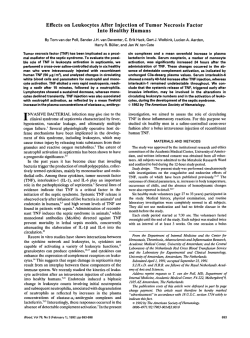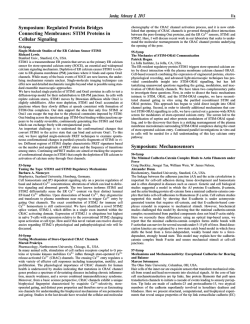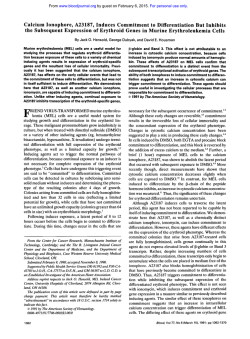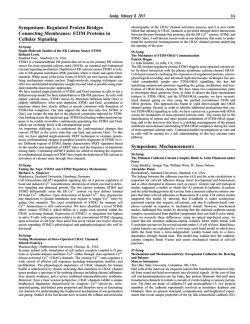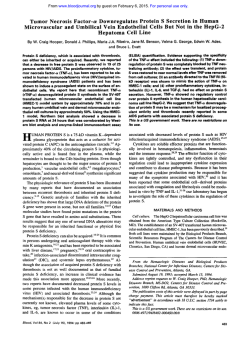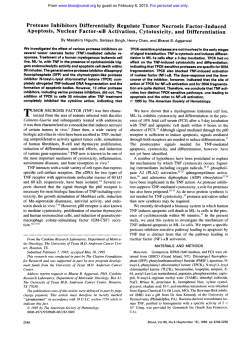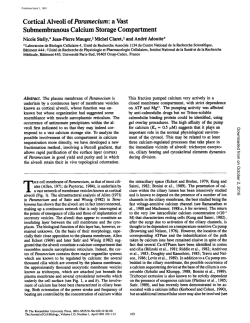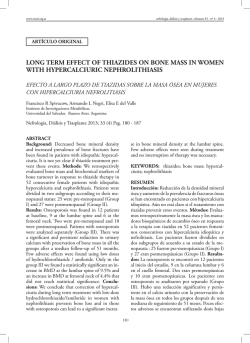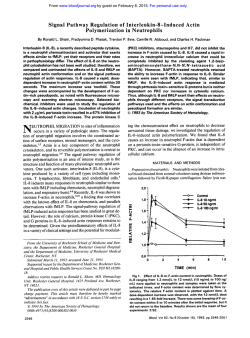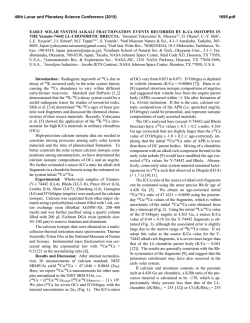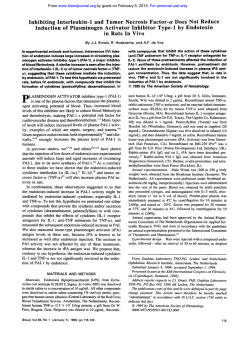
Increase in Cytosolic Calcium Upregulates the Synthesis of
From www.bloodjournal.org by guest on February 6, 2015. For personal use only. Increase in Cytosolic Calcium Upregulates the Synthesis of Type 1 Plasminogen Activator Inhibitor in the Human Histiocytic Cell Line U937 By Franck Peiretti, Chantal Fossat, Francine Anfosso, Marie-Christine Alessi, Mireille Henry, Irene Juhan-Vague, and Gilles Nalbone In the U937 histiocytic cell line, we investigated the effect of calcium-mobilizingagents with or without tumor necrosis factor-a (TNF) on the regulation of the synthesis of plasminogen activator inhibitor-type 1 (PAI-l). Cultured U937 cells were stimulated with ionophore A23187 and thapsigargin with or without TNF. The response was analyzed in terms of cytosolic calcium mobilization, PAL1 accumulation in the medium, and PAI-1 mRNA expression. The study was extended t o urokinase (uPA) secretion and surface expression of its receptor (uPAR). Using Fluo-3 as a calcium-indicator dye t o measure cytosolic calcium mobilization, we showed by flow cytometry that both agents mobilized calcium in a dose-dependent manner. TNF provoked a slight calcium mobilization that was also observedby digital imaging microscopy. Association of TNF with the calcium-mobilizing agents potentiated the calcium mobilization. Both calciummobilizing agents induced at 18 hours a dose-dependent accumulation of PAL1 in culture medium, whereasuPA was not affected. TNF alone induced a more marked accumulation of PAI-1than of uPA. Association of TNF with the agents induced a PAL1 response that was more than additive of the two, whereas the secretion of uPA was not enhanced. Membrane expression ofuPAR, measured by flow cytometry, tended t o be slightly augmented by the calcium-mobilizing agents only. All thetreatments resulted in a significant increase in PAI-1 mRNAlevel at 3 hours after the stimulation, which was very marked when calcium-mobilizing agents were present. Incubation of U937 cells in a calcium-free medium totallyprevented both themRNA expression andaccumulation of PAL1 inducedby calcium-mobilizingagents and, to lesser extent, that induced by TNF. The increase in PAI-1 mRNA expressiondid notrequire de novo protein synthesis, as cycloheximide did not suppress the increase in PAL1 mRNA induced by calcium-mobilizingagents. It is concluded that, in U937 cells, calcium triggers a pathway that upregulates PAL1 synthesis andpositively interacts with theTNFinduced pathway that stimulates PAI-1 synthesis. AsuPA and uPAR were differently affected, it is suggested that an increase in cytosolic calcium leads to a reduced pericellular proteolysis. 0 1996 b y The American Society of Hematology. T macrophages and smooth muscle cells of human atherosclerotic vessels.” Thus, it now becomes evident that an increase in PAI-1 not only may be related to the control of fibrin degradation at the luminal site of the endothelium or in the intima but also may affect local matrix proteolysis, thus controlling the migration of proliferating vascular cells and angiogenesis” or migratiodrecruitment of monocytes/macrophages.‘”14 Many of the pathophysiologic factors that are released or are present in the atherosclerotic vessels were demonstrated in vitro to significantly modify PAI-1 expression of cultured vascular cells. These include atherogenic cytokines such as tumor necrosis factor-a (TNF), and interleukin (IL)-l,I9-” and growth factor^.'^.^^ Calcium is believed to play a key role in numerous intracellular function~,’~.’~ some of which (eg, cell proliferation, apoptosis, angiogenesis, etc) are involved in the development of atherothrombosis. Some of the pathogenic factors mentioned above that augment PAI-1 synthesis were independently demonstrated also to alter by different ways the fine tuning of cytosolic calcium concentration. This is the case with oxidized low-density lipoproteins (LDL)26and various agonists that bind to tyrosine kinase-linked receptors, such as growth factors or Gprotein-linked receptors such as thrombin.27However, the role of calcium in the cytokine effect is not clear, and that of tumor necrosis factor-a (TNF) is still a matter of deIn atherosclerotic vessels, an important feature of vascular cells is that they are exposed to many signals, and a cross-talk between the resulting intracellular signalling pathways may occur. For example, TNF30,31 and calcium i n f l u ~ ~both ’ . ~ ~activate the mitogen-activated protein (MAP) kinase pathway. TNF potentiates calcium signals induced by b r a d ~ k i n i n and , ~ ~ the calcium ionophore ionomycin synergizes the phorbol ester-induced expression of uPA in a renal YPE 1 PLASMINOGEN activator inhibitor (PAI-1) is a serine protease inhibitor that rapidly inhibits the tissuetype plasminogen activator, thereby preventing activation of plasminogen into plasmin.’ This may result in a slowing down of fibrin degradation, both in the vasculature and at its surface. This is of prime interest, because a higher plasma level of PAI-1 is observed in patients with coronary heart diseases (CHD) and those presenting with insulin resistance, a syndrome that is associated with anincreased risk of CHD.’ As demonstrated by several independent groups, PAI-1 is released by activated platelets and produced in vitro by cultured vascular cells such as endothelial and smooth muscle cells.3 In vivo, a significant increase in the expression of PAI-1 mRNA has been observed byin situ hybridization techniques in human atherosclerotic By inhibiting the urokinase-type plasminogen activator (uPA) bound to its receptor (uPAR), PAL1 is also believed to be involved in the control of extracellular matrix degradation, which is a critical step for tissue remodeling, cell migration, and tumor i n v a ~ i o n . ”Interestingly, ~~ uPAR expression is augmented in From CJF INSERM 93-12, Laboratoire d’HCmatologie, Faculte‘ de Midecine, Marseille, France. Submitted April 3, 1995; accepted August 22, 1995. Supported by funds from INSERM, DRED, and Conseil Giniral des Bouches-du-RhBne. F.P.isa recipient of Minist2re de 1’Enseignement SupCrieur et de la Recherche. Address reprint requests to Gilles Nalbone, PhD, CJFINSERM 93-12, Laboratoire d’Himatologie,FacultC de Midecine, 27 Boulevard Jean Moulin, 13385 Marseille Cedex 5, France. The publication costsof this article were defrayedin part by page chargepayment. This article must therefore behereby marked “advertisement” in accordance with 18 U.S.C. section 1734 solely to indicate this fact. 0 1996 by The American Society of Hematology. 0006-4971/96/8701-0007$3.00/0 162 Blood, Vol 87, No 1 (January l ) , 1996: pp 162-173 From www.bloodjournal.org by guest on February 6, 2015. For personal use only. CALCIUMMOBILIZATIONAND PAL1 SYNTHESIS cell line.3' However, the role of calcium itself or in interaction with other agonists on PAI-1 synthesis has not been investigated. Enhanced expression of PAI-1 mRNA was detected in macrophages present in the atherosclerotic vessels' and those surrounding the lesion in an experimental model of thrombosis in the rabbit.36 Moreover, it has been demonstrated in vitro that peripheral blood monocyte^^'^^^ and macrophages isolated from human atheromatous plaque3' both secrete PAI- 1. Because the human lymphoma-derived histiocytic line U937 was shown to synthesize and secrete significant amounts of PAL2 and PAI-1,'2.40this cell line represents an interesting model to study the regulation of PM- 1 synthesis in the context of the role played by monocytedmacrophages in the development of atherothrombosis. Therefore, we investigated in U937 cells the effect of calcium-mobilizing agents on PAI-1 and uPA synthesis and uPAR membrane expression. The molecules studied were ionophore A23 187 and thapsigargin (TG), both of which increase cytosolic calcium in different ways. The former is well known to increase membrane permeability to calcium and also to discharge calcium from internal stores. The second irreversibly inhibits the endoplasmic CaZ+-ATPasepump that drives the ion back into the internal stores, thus creating a drastic desequilibrium in favor of a permanent leak of calcium in the cytosolic compartment:' The effects of ionophore A23187 and TG were also studied in association with TNF. Results showed that the agent-induced increase in cytosolic calcium upregulates PAL1 mRNA expression, leading to a drastic increase in PAL1 accumulation in culture medium. TNF alone stimulated PAL1 synthesis. Association of TNF and calcium-mobilizing agents potentiated the PAI-1 synthesis, indicating that in U937 cells, calcium positively regulates the TNF-induced increase in PAI-1 synthesis, while uPA and uPAR behaved differently. MATERIALS AND METHODS Chemicals. Fetal calf serum (FCS) and cell culture reagents were purchased from Eurobio (Les Ullis, France). A23187, TG, and dimethyl sulfoxide (Me,SO) were purchased from Sigma Chemicals CO (La Verpillibre, France). Human recombinant TNF-a (specific activity, 3.8 X lo7U/mg) was from Euromedex (Souffelweyersheim, (5 X lo7 Wmg) was from France), and human recombinant L-l@ Boehringer Mannheim (Meylan, France). Fluo-3-acetoxymethyl ester (Nuo3-AM) and 5,5'-dimethyl BAPTA-AM were from Molecular Probes (Eugene, Oregon). Nylon positively charged membranes and agarose were from Appligene (Illkirch, France). Monoclonal antibodies specific for PAI-I and cDNA human probes for PAI-l were a gift from Prof D. Collen, Prof P.J. Declerck, and Dr L. Nelles (Center for Thrombosis and Vascular Research, Leuven, Belgium). My0-[2-~H(N)]ionositolwas from NEN-Dupont (Paris, France). The murine monoclonal antibody (MoAb) directed against uPAR(no. 3936) was from American Diagnostic (Ortho Diagnostic Systems, Roissy, France). The fluorescein dichlorotriazinyl amino fluorescein (DTAF)-conjugated F(ab')* fragment goat anti-mouse IgG was from Immunotech (Marseille, France), and the negative irrelevant mouse IgGl was from Dako S.A. (Trappes, France). Cell culture. The U937 histiocytic cell line (provided by Dr A.M. Benoliel, Marseille, France) was maintained in suspension in Ham's F12Eagle.s minimal essential medium (MEM; 1/1 vol/vol) supplemented with 10% heat inactivated FCS, 2 mmovL L-gluta- 163 mine, 100 U/mL penicillin, and 100 pg/mL streptomycin, under 5% COz in a humidified atmosphere at 37°C. All the experiments, except video imaging, were performed at a cell density ranging between 1 X 106/mLand 2 X 106/mL. Assays. Cell viability was assessed by the quantification of lactate dehydrogenase (LDH) release in culture medium. To this end, the cell suspension was immediately centrifuged at 2,OOOg for 20 minutes at 4°C to sediment cells and cellular debris. Supernatants collected at 4°C were immediately assayed for the LDH assay using a routine clinical assay performed on an automatic analyzer (Hitachi 717, Boehringer Mannheim, Mannheim, Germany). Results were expressed in international units (IU) per IO6 cells. The rest of the supernatant was stored at -20°C. pending measurements of PAI-l and uPA accumulation in culture medium. PAL1 and uPA antigen assays were performed using an enzyme-linked immunosorbent assay (ELISA) as described by Declerck et al?2,43 Results were expressed in nanograms of PAI-l or uPA antigen (PAI-1 Ag or uPA Ag) per lo6 cells. Measurement of inositol phosphate production. U937 cells (2 X 106/mL)were. first incubated overnight in an inositol-poor medium (M199) containing my~-[~H]inositol (4 pCi/mL). Cells were washed twice and then incubated for 15 minutes with LiCl (40 mmolfl). They were stimulated either with TNF (100 U/mL) or IL-l (10 U/ mL) for various times, and the stimulation was stopped by addition of 10 mmolfl ice-cold formic acid. Inositol phosphates were then extracted and separated on Dowex anion exchange chromatography, as described by Vigne et al." Cell stimulation. In the experiments using calcium-mobilizing agents, cells in 1% FCS-containing medium were stimulated with the agent (A23187 in pure ethanol and TG in pure MezSO) added as a single dose at the indicated final concentration and left for 30 minutes. Proper controls with an equivalent volume of ethanol or MqSO alone were proven not to affect the responses studied. The stimulated cell suspension was then centrifuged for 5 minutes at 300g, 22"C, and the supernatant was carefully eliminated to remove the agents. The cellular pellet was resuspended inthe 1% FCS medium, and the length of incubation from the addition of the agent depended on the type of analysis performed: 18 hours for PAI-l Ag and LDH assays in the medium, and 1,3,5, and 18 hours for mRNA expression. In the studies involving association of agents and TNF, the cytokine was added as a single dose (final concentration of 100 U/mL) 2 hours before the agent. After the washing procedure, TNF was added again at the same concentration in the 1% FCS-containing medium, and incubation continued for indicated times as described above. The same procedure applied for TNF alone. In the experiments designed to study the effect of calcium-free medium, the 1% FCS-containing medium was supplemented with EGTA to completely chelate the calcium without any excess of EGTA (calciumfree medium). The measurement of calcium concentration in the culture medium using a routine clinical assay (Hitachi 717) confirmed that all the calcium was chelated. The cells were incubated in this medium for 2 hours, then were stimulated with calciummobilizing agents for 30 minutes, and were resuspended in the calcium-free medium. From the onset of stimulation, incubation lasted 3 hours for mRNA analysis and 18 hours for LDH and PAI-I Ag assays. In experiments using cycloheximide, the inhibitor was added at a final concentration of 15 pmol/L at 30 minutes before and until the end of the agent stimulation. Then, cycloheximide was continued at 3 pmoYL for the next 2.5 hours (&A expression) or 17.5 hours (PAL1 Ag secretion). This protocol was selected on the basis of a minimal cytotoxic effect under our experimental conditions of stimulation. Measurement of intracellular calcium mobilization byflow cytometry andfluorescence digital imaging. Intracellular calcium mobilization was measured by flow cytometry using the fluorescent probe From www.bloodjournal.org by guest on February 6, 2015. For personal use only. 164 Fluo3-AM, which has been shown to be a reliable dye to detect changes in cytosolic calcium." Fluo3-AM was dispersed in Me,SO containing 20% pluronic acid. In all the experiments, cells in1% FCS medium were incubated with 1 pmoVL Ftuo3-AM for 30 minutes, and experiments on dye-loaded cells were performed within the next 30 to 45 minutes. Indeed, we observed a substantial decay in basal fluorescence at 1 hour after the end of loading the cells, which seemed to perturb the fluorescenceresponse in cells stimulated with the calcium-mobilizing agents. This was not related to a dyeinduced cell membrane disruption, as cell viability measured by flow cytometry after iodine propidium treatment revealed that at least 95% of the cells were viable at the time of the measurement. This is perhaps the consequence of a spontaneous leakage of the probe out of the cell or of an intracellular metabolization into an inactive probe. In the experiments with a calcium-free medium, cells were first incubated in this medium for 2 hours, loaded with Flu03-M as above, and then stimulated with the agents before the fluorescence was read. To assess the time-dependent persistence of the intracellular calcium-mobilizing effect of the agents after they have been eliminated, U937 cells in 1% FCS-containing medium were stimulated for 30 minutes, the agents were removed, and the cells were resuspended in 1% FCS-containing medium. The dye was subsequently loaded at different times after the washing procedure, and fluorescence was directly read. Analyses were performed on an EPICS-Profile I1 cytofluorograph (Coulter Electronics Inc. Hialeah, K) equipped with an air-cooled, 488-nm argon-ion laser that was run at 15 mW of power. The linearity of the linear amplifier was performed using four different quantum-24 beads having 4,240, 17,000,38,000, and 77,900 fluorescein equivalents (Flow Cytometry Standards Corporation, Research Triangle Park, NC) per bead. For each measurement, 10,OOO events were collected and analyzed at typical rates of 400 to 600 cells per second. Cells were gated from debris and putative cell clumps on the basis of forward versus right angle scatter. Cells excited at 488 nm were detected at 525 nm. The green fluorescence, which represents the specific binding of cytosolic calcium, was measured on fluorescence channel 1 (FL 1) and collected after a 525-nm band pass filter. The data were collected in monoparameter histograms (256 channels) displaying relative log fluorescence intensity versus cell number by calculating the median channel number. Data acquisition on the flow cytometer was performed with the EPICS Profile software (Coulter Electronics). Normalized fluorescence is expressed as the ratio of mean fluorescence over mean basal fluorescence. Fluorescence digital imaging microscopy was also used to analyze calcium mobilization at the singlecell level in cells stimulated with either TNF (100 UlmL) or IL-l (10 U/mL). This was performed according to the protocol described by Kaplanski et Briefly, cells (500,000/mL)were loaded with Fluo3-AM as described above and examined with an Olympus IMT2 inverted microscope (Olympus, Tokyo, Japan) equipped with a Reichert heating stage (Reichert, Vienna, Austria). Fluorescence measurements were performed with a Lhesa 4036 SIT video camera (Lhesa, Cergy Pontoise, France) mounted on the microscope and connected to a PC vision + digitizer (Imaging Technology, Wobum, MA) set in an IBM-compatible desk computer. Changes in fluorescence were recorded every 6 seconds for a period of time up to IO minutes. Normalized fluorescence in a single responsive cell is expressed as the ratio of fluorescence over the basal fluorescence. Flow cyrometry analysis of uPAR expression. Quantitative expression of uPAR on U937 cells under the various conditions of stimulation was performed by flow cytofluometry, asdescribed." Briefly, IO6 cells were sedimented and treated for 2 minutes with 0.5 mL of 50 mmol/L glycine-HC1 pH 3.0, 100 mmol/L NaCl; then neutralized by addition of 0.5 mL 50 mmoVL HEPES pH 7.5, 100 mmoVL NaCl, and immediately centrifuged. The cells were washed twice with ice-cold phosphate-buffered saline (PBS)/O.1% bovine PElRETTl ET AL serum albumin (BSA) containing 0.1% sodium azide and incubated with the murine MoAb 3936 at a concentration of 2 pg/mL for 30 minutes at 4°C. After extensive washing, cells were incubated for 30 minutes at 4°C with the fluorescein DTAF-conjugated anti-IgG (dilution, 11200). After extensive washing, the cells were fixed overnight with 2% paraformaldehyde and analyzed by flow cytometry as described above. Nonspecific binding was assessed by replacing MoAb 3936 with an irrelevant mouse IgGI. Preparation of RNA, cRNA probes, and Northern blot analysis. Total RNA of U937 cells was extracted according to the method of Chomczynski et Total RNA (15 pg) was fractionated by electrophoresis on 1% gel agarose containing 20% formaldehyde. RNA was transferred under vacuum to a positively charged nylon membrane. The antisense cRNA probe of PAL1 was transcribed in vitro from linearized recombinant plasmid (containing the 436-bp fragment from nucleotide 1045 to 1481 of human PAI-l) using digoxigenin-l l-uridine triphosphate and SP6 RNA polymerase (Boehringer Mannheim) according to the protocol described by Melton et al.49 The digoxigenin-labeled human P-actin antisense cRNA probe was from Boehringer Mannheim Biochemical. Hybridization was performed with the digoxigenin-labeled antisense cRNA probes of human PAL1 and p-actin for 16 hours at 68°C under gentle stirring, as previously described?' Detection of the RNA-cRNA hybrid was performed using a chemiluminescent detection kit as described by the manufacturer (Boehringer Mannheim Biochemical, no. 1363514). Briefly, after hybridization, blots were incubated with an antidigoxigenin MoAb conjugated to alkaline phosphatase. The reaction was initiated by addition of alkaline phosphatase substrate, and the membrane was exposed to an autoradiography film for a period of time ranging between 15 and 30 minutes. RESULTS Effect of A231 87, TG, TNF, and IL-l on cytosolic calcium mobilization. A23187 and TG are well known to induce in various types of cells, each via a different way, an increase in cytosolic calcium concentration. We analyzed byflow cytometry the characteristics of cytosolic calcium mobilization induced by these molecules. Cells were stimulated with A23187 or TG at the indicated concentrations. Fluorescence was read10 seconds and 60 seconds after addition of A23 187 and TG, respectively, which was determined to be the optimal time for each. With A23187, increasing the dose up to 1 pmol/L leadto a significant increase in intensity of fluorescence. Above 1 pmol/L, no further increase in fluorescence was observed (Fig 1A). TG also induced a dosedependent increase in fluorescence, much less markedin intensity but occurring at a concentration 10 times lower thanwithA23187 (Fig 1B). The dose response appeared narrower with TG than with A23187 and reached a plateau at approximately 0.5 pmoVL and 0.05 pmol/L with A23 187 and TG, respectively. To further confirm the calcium-mobilizing effect of the agents, we analyzed the calcium mobilization in cells preincubated in a calcium-free medium for 2 hours and subsequently stimulated. The fluorescence was read 10 and 60 seconds after the stimulation with A23187 and TG, respectively. Compared with cells in a normal calcium concentration, we observed a drastic diminution of the fluorescence signal when cells were incubated in the calcium-free medium and stimulated with the agents (Fig l , insets). The diminution of the signal attained 93% and 80% for A23187 and TG, respectively. Replacing calcium in the culture medium at a final concentration of 2 mmoVL for I5 From www.bloodjournal.org by guest on February 6, 2015. For personal use only. CALCIUMMOBILIZATION AND PAI-l SYNTHESIS 165 minutesalloweddetection of a fluorescencesignalwhen or TG, although for both cells were stimulated with A23 187 the signals were slightly less intense than under normal conditions of stimulation (Fig 1, insets). We then investigated the calcium mobilizationin cells stimulatedby TNF with or without the agents. Cells were treated for 2 hours with TNF, loaded with the dye, and then stimulated with either A23187 or TG,andthefluorescencewasread 10 seconds and 60 secondsafterthestimulation,respectively.Resultswere comparedwithcellsstimulatedwithcalcium-mobilizing 15 2 0 t Q V c Q V 2 0 3 -c 7 a EV -c 2 9 E Q A 11 m m A T 13 T l Il- 5 3 1 0 t Fig 2. Calcium mobilization in U937 cells by TNF, A23187, TG, or agents in association with TNF, as measured by flow cytometry. Cells were incubated for1.5 hours in l % FCS with or withoutTNF (100U/ mL1, then incubatedwith 1 pmol/L Fluo3-AM, and stimulated ornot with A23187 l1 pmollLI orTG (0.1 pmol/Ll. Normalizedfluorescence values calculated as in Fig 1 are the means (+SDI of two separate experiments, each performed in duplicate. Q V c Q V 01 E0 zl E c Q m to EV -c I 0.0 1.o 0.5 1.5 I ' 2.0 2.5 A23187 (wM) "I 2.0 1.2 , 1.0 0.0 0.1 ,l, 1.Q 0.3 0.4 fhapsigargin (PM) 0.2 , ( 0.5 -I 0.6 Fig l.Dosedependent effect of calcium-mobilizing agentson cytosolic calcium mobilization in U937 cells as measured by flow cy. tometry. Cells in 1% FCS medium were loaded with Fluo3-AM for 30 minutes and then stimulated with the calcium-mobilizing agent. Fluorescence was read before and then10 seconds and 60 seconds after the addition A23187 of (A) and TG (B),respeetively. Normalized fluorescence values (ratio of the means after stimu1ation:before stimulation) are the means (+SDI of two separate experiments, each performed in duplicate. Insets Effect of extracellular EGTA on calcium mobilization in cells stimulated bylpmol/L A23187 (A) or 0.1 pmol/L TG (B).Control cells, solid bars; plus EGTA, open bars; reintroduction of calcium for 20 minutes, shaded bars. Values are the means (+SDI of two separate experiments, each performed in duplicate. agents alone or TNF alone. As shown in Fig 2, TNF alone induced a modest increasein fluorescence within the minutes that followed stimulation. Similar observations were made with IL-l at 10 UlmL (not shown).A potentiation of calcium mobilization induced by the association of TNF with either A23187 or TG was noticed, as more than an additive effect was observed. The weak fluorescent signal induced by TNF maybe inherenttoflowcytometrymeasurements,which may average a heterogenous response within a cell population. To further explore the calcium mobilization induced by TNF, we analyzed the response aatsingle-cell level using digitalimagingmicroscopy.Resultswereconsistentwith flow cytometry observations, as about 40% of the cells responded to TNF within the first 10 minutes and displayed a in Fig 3. In our experimenheterogenous response, as shown tal protocol of stimulation designed to study the regulation of PAL 1 synthesis, cells were stimulated for 30 minutes, the in 1% agentwasremoved,andincubationwascontinued FCS (see below). Therefore, we investigated by flow cytometry how long the increase in the level of cytosolic calcium persisted in cells after removal of the agent. As shown in Table 1, A23 187-stimulatedcells did not sustain an elevated cytosolic calcium level, as 30 minutes after the removal of A23187,thefluorescencenearlyreturnedtothelevelof control cells.In contrast, in TG-stimulated cells, the fluorescenceremainedat a constantlevelcomparablewiththat read at the initial measurement (compare with Fig 1). This indicates that the effect of TG on intracellular calcium, in contrast with that of A23 187, persisted after its removal from the medium. We investigated if the weak calcium mobilization induced by cytokineswasmediated by inositolphosphate-3(IP3) release. After labeling the cells with rny~[~H]inositol, they were stimulated with either TNF (100UlmL) or IL-I (10 U/ mL) for 0,2,5, 10, and 15 minutes. Any significant increase From www.bloodjournal.org by guest on February 6, 2015. For personal use only. 166 PElRElTl ET AL f V . 0.5 0 1.0 l.S 2.0 A23187 (PM) 0 30 60 120 90 Time 150 180 (S) Fig 3. Patterns of TNF-induced calcium mobilization at a singlecall level, as measured by digital imaging microscopy. U937 cells were incubated with 1 pmol/L Fluo3-AM for 30 minutes and stimulated with TNF (100 UlmL). Fluorercence was recorded every 6 seconds as described in Materials and Methods. Five typical curves are shown. in IPS above the control level was detected in these conditions (data not shown). Effects of A23187, TG, and cytokines on PAI-I accumulation in the culture medium. Cells in 1% FCS medium were stimulated for 30 minutes with increasing doses of A23187 or TG. As showninFig 4, both agents induceda dosedependent effect on PAI-1 accumulation, which was more pronounced with TG than with A23187. The response was linearly related to a dose up to 1 pmol/L and 0.1 p m o K for A23187andTG, respectively, andthendeclined for A23187 and plateaued for TG. Evaluation of cell viability, Table 1. Measurement by Flow Cytometry of the Penistence of Calcium Mobilization in U937 Cells PreviouslyStimulated With A23187 or TG Time After Removal of the Calcium-Mobilizing Agent (min) Agent A23107 TG 30 60 90 1.3 ? 0.16 1.94 ? 0.26 1.05 2 0.11 2.55 2 0.21 1.05 2 0.10 2.18 2 0.45 Cells in 1% FCS medium were stimulated for 30 minutes with A23187 (1 pmol/L) or TG (0.1 pmol/L), washed, and resuspended in 1% FCS medium. Cells were loaded with Fluo3-AM for 30 minutes, and then fluorescence was measured at the indicated time. Detailed experimental conditions of flow cytometry analysis and data processing are described in Materials and Methods. Values (ratio of fluorescence in stimulated cel1s:fluorescence in unstimulated cells) are indicated as fold-increases in fluorescence and are the means ( S D ) of two separate experiments, each performed in duplicate. 00.2 0.1 0.3 Thepsigargin 0.4 0.5 0.6 (PM) Fig 4. Dose-dapendent affectof cakium-mobilizing agents on PAI1 Ag accumulation in medium from U937 cells. Celtsin 1% FCS medium were stimulated for 30 minutes with A23187 (A) or TG (B). Then, cells were washed and resuspended in 1%FCS medium as indicated in Materials and Methods. Media ware collected 18hours after the addition of the agents. Unstimulated control calls were similarly handled. Valuea are the means SD of three separate experiments, each performed in triplicate. * performed by thetrypanblue dye exclusion test,didnot reveal significantly highercell injury, except for at the highest dose of A23187. This is confirmed by the measurement of LDH in culture medium, which showed for this dose an increased release in the culture medium (X4) that represents about 30% of the total intracellular LDH that can be released (data not shown). Therefore, the decrease in PAI-1 accumulation at 2 pmoVL A23 187 could be related to a cytotoxic effect of the molecule at this concentration. Combining the results of the dose-dependent calcium mobilization (Fig 1) and PAI- 1 accumulation (Fig 4) enabled us to set the experimental concentrations of A23187 and TG in all subsequent studies at 1 pmoYL and 0.1 pmoVL, respectively. The doses of 100 U/mL of TNF and 10 U/mL of IL- 1optimally induced over control cells about 22 times and five times more secreted PAL1 Ag, respectively. TNF at 100 U/mL was, thus, selected inthesubsequent studies. When TNF-stimulated From www.bloodjournal.org by guest on February 6, 2015. For personal use only. CALCIUMMOBILIZATIONAND PAL1 SYNTHESIS Control 1 167 TNF A23187 2 3 TG TNFtA23187 4 5 TNFtTG 6 Fig 5. Effect of TNF, A23187, TG, or agents in association with TNF on PAI-1 synthesis. (A) Effect on PAL1 accumulation. Stimulation with A23187 alone (1pmollL1 or TG alone (0.1 pmol/L) was performed as in Fig 4. In the experiments with TNF alone, TNF was added as a single dose 1100 UlmL) and left for 2.5 hours. Cells were then washed, and TNF (100 U/mL) was added again as a single dose. In the experiments associating TNF and agent, the agent was added 2 hours after initial addition ofTNF and left for 30 minutes, and the experiment continued as indicated above. Media were recovered 18 hours after agent addition (ie, 20 hours after initial TNF addition). There was no significant difference in the accumulationof PAL1 whether the agent was added at the same time as TNF (not shown) or 2 hours after. Values are the means t SD of t w o separate experiments, each performed in triplicate. (B) Effect on PAL1 mRNA expression. RNA was extracted at a fixed time (3 hours after agent addition). Additions are, from left t o right, in the same order as in panel A. Scanning densitometry of the PAL1 mRNA signal relativeto mRNA p-actin signal shows the following values from leftt o right: 0, 0.28, 1.8, 2.6,2.2, and 2.8. This Northern blot is representative oft w o separate experiments. cells were incubated for 30 minutes with A23187 ( I pmol/ L) or TG (0.I pmol/L), the accumulation of PAI- 1 was more than additive of the two separately (Fig S). In all the situations, the protein synthesis inhibitor cycloheximide drastically abolished the increase in PAL I accumulation, indicating that neither agents nor TNF induced the release of a preformed pool of PAI-I. To confirm the role of calcium in PAI-I release, cells were preincubated in a calcium-free medium 2 hours before the stimulation and throughout the experiment. Results were compared with those treated under the same conditions at normal calcium concentration. Results are listed in Table 2. Incubation in the calcium-free medium almost totally preventedthe A23187- or TG-induced increase in PAI-l. Incubation in a calcium-free medium was not cytotoxic as judged by LDH release. However, those stimulated with A23 187 in the calcium-free medium released slightly more LDH (+40%). Deprivation of extracellular calcium reduced by about 47% the TNF-induced increase in the release of PAI-I. Insets in Fig I show that even after a preincubation with EGTA, calcium is still mobilizable by agents, although weakly. This minor pool may account for the remaining 53% of PAI-I in EGTA-treated cells stimulated with TNF. Therefore, we used the intracellular calcium chelator BAPTA-AM at a concentration of 1 pmol/L, which was shown not to be cytotoxic at this concentration. Cells were preincubated with EGTA for 2 hours and then incubatedwithBAPTA-AM for 30 minutes.Wefirstchecked byflow cytometry that the stimulation of these calciumchelated cells by A23 187 did notinduce any greater increase in fluorescence, attesting for the complete absence of mobiTable 2. Effect of EGTA and BAPTA-AM on PAL1 Accumulation in Culture Medium From U937 Cells Conditions Normal calcium EGTA BAPTA-AM EGTA + BAPTA-AMC A23187 TG TNF I1 umollLl (0.1 umolR) 1100 UIrnLl Unstimulated 100 1.2 ND ND 100 100 302.8 ND ND 100 53.1 184.8 61.9 350 ND Cells were preincubated for 2 hours with EGTA before stimulation and left throughout the experiment. BAPTA-AM was added 30 minutes before stimulation and left throughout the experiment. Values, expressed as percent of the PAL1 Ag release observed with normal calcium concentration (standard calcium), are the means of two separate experiments, each performed in triplicate. For each treatment, the 100% ranged in the values shown in Fig 5. Abbreviation: ND, not determined. The so-called "calcium-chelated" cells. From www.bloodjournal.org by guest on February 6, 2015. For personal use only. PElRElTl ET AL 168 Table 3. Effect of Various Treatments on uPA Accumulation in the Medium and uPAR Membrane Expression in U937 Cells uPAR (specific mean fluorescence) uPA (ng11O6cells). 18 h Treatment Control TNF A23187 TG TNF + A23187 TNF + TG 1.37 4.47 1.10 0.90 2.86 3.39 ir 0.17 10 h 5h 18 h 0.45 ir 0.04 0.63 ir 0.07 0.60 t 0.2 2 0.89 0.44 ir 0.04 0.42 2 0.07 0.42 ir 0.39 2 0.83 ir 1.34 % 0.47 0.41 0.39 0.39 ir 0.05 0.89 ir 0.11 0.64 t 0.05 0.86 t 0.10 0.60 t ir t ir 0.60 0.21 0.99 0.15 0.73 0.17 0.80 0.014 0.91 ir 0.25 2 0.32 ir 0.25 ir 0.22 ir 0.51 U937 cells were treated as described in Fig 5. Details of assay conditions are described in Materials and Methods. Fluorescencevalues are expressed as the mean of fluorescence and were corrected for fluorescence measuredwith irrelevant IgG as a negative control. Values are the means -c SD oftwo separate experiments,each performed in duplicate. lizable calcium. These calcium-chelated cells were stimulated by TNF for 18 hours. Table 2 shows that TNF-induced PAI-I release from calcium-chelated cells was similar to EGTA-treated cells. This indicates that the remaining intracellular calcium after EGTA preincubation is not responsible for the TNF-induced PAI-I secretion from EGTA-treated cells. Curiously, TNF-treated cells incubated with BAPTAAM released about twice more PAI-I than cells treated with TNF alone. In unstimulated control cells, deprivation of extracellular calcium reduced the basal accumulation of PAI1 by 70%, whereas BAPTA-AM increased the basal accumulation by about a factor of 3. Effect of A23187, TG, and TNF on uPA accumulation in culture medium and uPAR membrane expression. The same experimental conditions were applied to analyze the synthesis of uPA and its receptor (Table 3). Calcium-mobilizing agents alone didnot induce significant alteration in uPA Ag accumulation in the culture medium, whereas TNF produced about a threefold increase over the control cells. Association of TNF with either A23187 or TG tended to decrease the TNF-induced increase in uPA Ag. Flow cytometry analysis ofuPAR showed that its membrane surface expression was not significantly altered by TNF at 5, 10, and18hours. However, calcium-mobilizing agents either alone or in association with TNF tended to increase the surface expression of uPAR mainly at 18 hours when com- pared with unstimulated cells. Although statistically not significant, the effects appeared slightly moremarkedat 10 hours and 18 hours with A23 187( + 4 1 8 and +65%, respectively) thanwith TG ( + 2 1 8 at 18 hours). As a positive control of uPAR surface expression, U937 cells were treated twice with 5 pmol/L of phorbol myristate acetate (PMA) at 24-hour intervals. Approximately a 10-fold increasedsurface expression of uPAR was detected in PMA-treated cells over control cells (data not shown). Effect ?f A23I87, TG, and TNF on PAI-I mRNA level. To see if the augmentation of PAI-I release in medium induced by calcium-mobilizing agents waslinked to its mRNA expression, we analyzed by Northern blot the PAI1 mRNA expression at different times after stimulation with calcium-mobilizing agents. As shown in Fig 6, PAI- I mRNA (3.2 and 2.3 kb transcripts) expression was strongly induced 3 hours after the onset of agent stimulation and then declined at 5 hours both for A23 187 andTG. At I8 hours, expression almost disappeared with A23187, whereas the signal remained quite stable with TG. TNF alone or in association with the agents was then studied. TNF alone ( 1 0 0 U/mL; Fig 7A and B) induced a slight PAI-I mRNA expression 3 hours after the onset of stimulation. The signal remained the same at 5 hours and disappeared at 7 hours. When calciummobilizing agents were added in association with TNF (Fig 7A and B), the profile of the time-dependent PAI-I mRNA expression was comparable with that observed when the agents were added alone (compare with Fig 6); ie, with TG, the expression of PAI-I mRNAremained quite constant from 7 hours up to 18 hours, whereas with A23187, it declined. To see the effect of the association of TNF with calcium-mobilizing agents on PAI-I mRNA, we compared its expression at a fixed time (3 hours after the addition of the agent, ie, 5 hours after initial addition of TNF) under different conditions: control, 1% FCS; TNF (100 U/mL); A23 187 (1 pmol/L); TG (0.1 pmol/L); TNF + A23 187; and TNF + TG. As shown in Fig 5, the effects of TNF associated either with A23187 or TG appear additive of the two. In all situations, @-actin takenas a control showed slight modifications that were unrelatedto the drastic modifications obtained with PAI-I mRNA. To examine if the observed increase in PAI-I mRNA required a de novo protein synthesis,cells were treated with cycloheximide. Treatment with the protein synthesis inhibitor did not suppress agent-induced PAI-I mRNA A R J- PAI-1 p-ACTIN [ 1 2 3 4 1 2 3 4 Fig 6. Time-dependent effect of calcium-mobilizingagents on PAL1 mRNA expression in U937 cells. Cells were stimulated as indicated in Fig 4, and RNA was extracted at l hour (lane l), 3 hours (lane 21, 5 hours (lane 3).and 18 hours (lane 4) after the onset of the stimulation by A23187 (A) or TG (B). This Northern blot is representative of three separate experiments. From www.bloodjournal.org by guest on February 6, 2015. For personal use only. CALCIUM MOBILIZATION AND PAI-1 SYNTHESIS 169 A I i PAL1 ~~ Fig 7. Time-dependent effect of TNF alone or in association with either A23187 or TG on PAI1 mRNA expression in U937 cells. The protocol of stimulation is the same as in Fig 5. CO and C20, control cells in 1% FCS at times 0 and 20 hours, respectively. Cells were stimulated with TNF alone (-1 or in association with agents (+) A23187 (A) and TG (B).Total RNA was extracted 3,5,7.and 20 hours after the initial TNF addition (ie, 1, 3, 5, and 18 hours when considering the addition of the agent). These Northern blots are representative oftwo separate experiments. CO ~ c20 ,- +l +I j- L +I 1- I B [ 13.2 kb ~ CO c20 1- +I j - +I c expression, which was even higher for the 3.2-kb form (Fig 8). PAI-I mRNA expression of cycloheximide-treated cells was identical to that of control cells (data not shown). The effect of calcium-free medium on PAI-I mRNA expression in cells stimulated with A23 187 or TG was investigated. Interestingly, the A23187- or TG-induced increase in mRNA normally observed 3 hours after the beginning of stimulation in standard calcium concentrationwas now completely abolished by deprivation of extracellular calcium (Fig 8). DISCUSSION We investigated the role of calcium-mobilizing agents (ionophore A23187 and TG) alone or in association with TNF in the regulation of PAI-I synthesis and extended the study to include uPA and uPAR. Both calcium-mobilizing agents induced a drastic increase in PAI-I accumulation in the cul- 2 3 +, I 2.3 kb - ,t t 7 t 5 t 3 1 +I t 20 t 7 t 5 t 3 PAI-1 - 3.2 kb 2.3 kb +I 20 ture medium. Three arguments are in favor of a calciummediated effect. (1) The two structurally unrelated molecules dramatically stimulated PAI-I accumulation, thus ruling out a possible side effect unrelated to calcium. (2) A comparable shape of the dose-dependence curves of PAI-I release and calcium mobilization was observed with either A23187 or TG. (3) The complete chelation of extracellular calcium drastically prevented the agent-induced increase in PAI-Irelease. This is reflected by flow cytometry analysis, revealing that in cells cultured for 2 hours in a calcium-free medium, calcium mobilization was strongly reduced. Therefore, depletion of theextracellular calcium 2 hours beforestimulation practically emptied the agent-sensitive intracellular stores by a progressive efflux of calcium from these stores to the outside of the cell. This is in agreement with studies clearly showing that a calcium-free mediumresulted in a significant loss of calcium from intracellular How- 4 5 6 Fig 8. Effect of calcium-free medium and cycloheximide onPAL1 mRNA expression in U937 cells stimulated with eithercalcium mobilizing agent. Cells in 1% FCS were stimulated with A23187 (A) or TG (B)for 30 minutes, and total RNA was extracted 3 hours after the additionof the agent. Experimental conditions with calcium-free medium were thesame as in Table 1, except the experiment lasted3 hours. Protocol for cycloheximide is detailed in Materials and Methods. A23187 alone, lane 1; A23187 + cycloheximide, lane 2;A23187 in calcium-free medium, lane 3; TG alone, lane 4; TG + cycloheximide, lane 5; TG in calcium-free medium, lane 6. This Northern blot isrepresentative of two separate experiments. From www.bloodjournal.org by guest on February 6, 2015. For personal use only. 170 ever, chelating extracellular calcium did not irreversibly affect the ability of cells to maintain calcium homeostasis. The upregulation of PAL 1 accumulation induced by elevated levels of cytosolic calcium is not due to the secretion of a preformed pool of PAI-1. First, cycloheximide suppressed the agent-induced secretion of PAI-l. Secondly, the PAL1 mRNA expression was drastically increased after stimulation by either A23 187 or TG. The effect of TG on PAI-1 mRNA expression persisted for a longer time than that of A23187. This may be the result of the irreversible inactivation of the Ca2’-ATPase pump by TG?’ which prolonged the increase in cytosolic calcium for a longer period than with A23187. Indeed, we showed that the calcium-mobilizing effect of TG remained at its initial value 90 minutes after the agent had been eliminated, whereas it disappeared rapidly with A23187. Whether this higher level of mRNA is due to an enhanced transcription rate of the gene andor a higher stabilization of PAL1 mRNA has not been investigated here. Because the basal level of PAI-1 mRNA in quiescent cells is undetectable, it is likely that the markedly elevated level of PAI-l mRNA after stimulation mainly results from an enhanced transcription process. However, a stabilizing effect on PAI-l mRNA cannot be ruled out, as it has been demonstrated with A23187 on IL-3 ~ I R N A . ’A~ calcium-free medium totally prevented the increase inmRNA expression after stimulation by the calcium-mobilizing agent, which again reinforces the role of calcium as an important intracellular messenger involved in the regulation of PAI-I gene expression. The calcium effect does not require a de novo protein synthesis, because treatment of cells with cycloheximidedidnot suppress A23187- and TG-induced PAI-I mRNA expression. A slight overincrease in the 3.2-kb transcript expression was observed, a phenomenon explained by a stabilizing effect of cycloheximide on this mRNA.s4.55 The interaction of calcium-mobilizing agents with TNF is of interest. TNF upregulates PAL1 production and mRNA expression in U937 cells, which has already been reported in various tissues” and other types of cells.57The role of calcium mobilization in signal transduction by TNF is still controver~ial.*~*~~ Some of the discrepancies reported can be explained by the calcium-buffering capacities of the fluorescent probe used” and/or by the different sensitivity of cells to TNF. Using Fluo3, we found in U937 cells that TNF alone weakly mobilized calcium. In other types of cells, the use of F ~ r a 2 ’ did ~ , ~not allow detection of any significant calcium increase after stimulation by TNF even at very high doses:’ whereas in human neutrophils stimulated with TNF at 1,000 U/mL, calcium oscillations were observed with Flu03 in some of the responsive cells.62The modest increase we observed with TNF did not appear to be the result of a calcium release from IP3-sensitive stores, as we could not measureany significant IP production. This is consistent with previous results6’ and with our digital imaging microscopy observations that showed a heterogeneous slow calcium increase in about 40% of cells. IP3 is known to be rapidly produced and toinduce within minutes a transient significant increase in calcium. However, the possibility that a secondary, very late, and low sustained increase in IP3 occurs cannot be ruled out.@It is evident from our results that calcium PEIRElTI ET AL is not indispensable but does contribute to the TNF-induced pathway of PAI-1 synthesis. In support of a contributive role, calcium-mobilizing agents and EGTA have an opposite effect on PAI-1 Ag production triggered by TNF. On the other hand, calcium is not indispensable for TNF action. because in experiments in which bothextracellular and intracellular calcium have been buffered, TNF still induced about 60% of PAI-1 release. The individual opposite effects of BAPTA-AM and EGTA on PAL1 synthesis in TNF-stimulated cells deserve some comments. By preventing the refilling of intracellular stores, BAPTA-AM may secondarily induce a calcium influx, in a comparable manner to the effect of TG.6’-hs Inthe presence of TNF and EGTA, BAPTA-AM did not further lower the reduced PAI-1 response provoked by EGTA, suggesting that chelation of extracellular calcium was a determinant to reduce the TNF action on PAL I synthesis. Collectively, these data suggest that calcium influx plays an important role in the upregulation of PAL1 synthesis triggered by TNF. Recently, it was found in adherent human fibroblasts that extracellular calcium predominates in IL- I stimulated calcium Thus, we can hypothesize that a calcium influx induced by either TNF or calcium-mobilizing agents primes at a certain step a common pathway thatregulates PAI-1 expression. The tyrosine kinase pathwayis a possible candidate. Recently, it has been shown in human endothelial cells that TNF-induced increase in PAI-1 gene transcription follows a genistein-sensitive pathway involving a tyrosine kinase phosphorylation ~ t e p . ~Interestingly, ” in human lymphocytes, the influx of calcium controlled by the filling state of intracellular calcium pools is regulated by the tyrosine kinase activity.” Also, TNF”,” and calcium activate the MAP kinase pathway, and TNF potentiates calcium signals induced by brad~kinin.’~ The potentiating effect of agents on calcium mobilization and PAI-l synthesis in TNF-stimulated cells could not be observed at the level of PAL1 mRNA. The stability and export of mRNA and the translation efficiency are intermediate control mechanisms that may be significantly altered by the different treatments, thus preventing establishment of a rigorous relationship between mRNA expression and its corresponding protein released in the culture medium. Therefore, whether this effect acts at a transcriptional, posttranscriptional, or translational level cannot be determined on the basis of the present data. The triad PAI-l/uPA/uPAR is believed to regulate pericellular proteolysis, which conditions cell rnigrati~n.~~’’ We, therefore, investigated uPA and uPAR expression. We found that uPAR membrane expression was not significantly altered by TNF and was weakly altered by calcium-mobilizing agents 18 hours after the stimulation. However, uPAR surface expression may be transient. First, uPAR can be internalized by the low-density lipoprotein receptor-related protein (LRP) together with uPA/PAI-I and recycled back to the membrane.72Second, uPAR can bereleased from the membrane into the medium.’’ Thus, we investigated the possibility that we missed a more marked transient uPAR expression before 18 hours.This does not appear to be the case, because no significantly higher surface expression could be observed over control cells at 5 hours and 10 hours after the Stimulation. Thus, it is reasonable to assume that within the From www.bloodjournal.org by guest on February 6, 2015. For personal use only. CALCIUM MOBILIZATION AND PAL1 SYNTHESIS duration of the experiment, only calcium-mobilizing agents tended to induce a weak uPAR surface expression. Under our experimental conditions (ie, 18 hours after the stimulation), A23187 or TG alone did not increase uPA accumulation in the medium, which is in accordance with previous data.35 TNF increased uPA release as already although to a much lesser extent than PAI-1. Interestingly, calciummobilizing agents did not potentiate TNF-induced uPA release, indicating that the upregulation exerted by the calcium agents either themselves or in interaction with TNF appears specific for PAI-1 within the proteins regulating the surface proteolysis. It may be hypothesized that in monocytes the calcium-mediated signal that specifically upregulates PAI- 1 production shifts the pericellular proteolytic potential toward hypoproteolysis or hypofibrinolysis. In conclusion, our results demonstrate the role of calcium as being an intracellular messenger able to upregulate the expression of PAI-l in U937 cells and also to interact with TNF by potentiating its effect. This process may be of prime importance inthe migration andrecruitment of activated monocytes/macrophages during atherosclerosis, as recently sugge~ted,'~.'~ orin the focal accumulation of PAI-1 in a lesion contributing to fibrin deposition. ACKNOWLEDGMENT We are indebted to R. Lijnen (Louvain, Belgium) for uPA assays, A.M. Benoliel (INSERM, Marseille, France) for digital imaging microscopy, P. Vigne (CNRS, Sophia-Antipolis, France) for the IP3 assay, and Dr H. Lu (INSERM, Paris, France) for his suggestions. We are grateful to N. Fernandez for excellent technical assistance (flow cytometry); J. Ansaldi and M. Luchi (PAI-I Ag assay); the Laboratoire de Biochimie, CHU-Timone (LDH assay); and S. Debroas and A. Olivi for technical help. REFERENCES 1. Hekman CM, Loskutoff DJ: Kinetic analysis of the interactions between plasminogen activator inhibitor 1 and both urokinase and tissue plasminogen activator. Arch Biochem Biophys 262:199, 1988 2. Juhan-Vague I, Alessi MC: Plasminogen activator inhibitor 1 and atherothrombosis. Thromb Haemost 70:138, 1993 3. Andreasen PA, Georg B, Lund LR, Riccio A, Stacey SN: Plasminogen activator inhibitors: Hormonally regulated serpins. Mol Cell Endocrinol 68:1, 1990 4. Schneidermann J, Sawdey MS, Keeton MR, Bordin GM, Bernstein EF, Dilley RB, Loskutoff DJ: Increased type 1 plasminogen activator inhibitor gene expression in atherosclerotic human arteries. Proc Natl Acad Sci USA 89:6998, 1992 5. Lupu F, Bergonzelli GE, Hein DA, Cousin E, Genton CY, Bachman F, Kruithof EKO: Localization and production of plasminogen activator inhibitor- 1 in human healthy and atherosclerotic arteries. Arterioscler Thromb 13:1090, 1993 6. Chomiki N, Henry M, Alessi MC, Anfosso F, Juhan-Vague I: Plasminogen activator inhibitor-] expression in human liver and healthy or atherosclerotic vessel walls. Thromb Haemost 72:44, 1994 7. Grimaldi G, Di Fiore P, Locatelli EK, Falco J, Blasi F Modulation of urokinase plasminogen activator gene expression during the transition from quiescent to proliferative state in normal mouse cells. EMBO J 5:855, 1986 8. Pepper MS, Sappino AP, Montesano R, Orci L, Vassali JD: Plasminogen activator inhibitor-l is induced in migrating endothelial cells. J Cell Physiol 153:129, 1992 9. Schneiderman J, Sawdey M, Craig H, Thinnes T, Bordin G, 171 Loskutoff DJ: Type 1 plasminogen activator inhibitor gene expression following partial hepatectomy. Am J Pathol 143:753, 1993 10. Thornton AJ, Bruzdzinski CJ, Raper SE, Gelehrter TD: Plasminogen activator inhibitor-] is an immediate early response gene in regenerating rat liver. Cancer Res 54:1337, 1994 11. Noda-Heiny H, Daugherty A, Sobel BE: Augmented urokinase receptor expression in atheroma. Arterioscler Thromb Vasc Biol 15:37, 1995 12. van Hinsbergh VWM, Kooistra T, Emeis JJ, Koolwijk P Regulation of plasminogen activator production by endothelial cells: Role in fibrinolysis and local proteolysis. Int J Radiat Biol 60:261, 1991 13. Lundgren CH, Sawa H, Sobel BE, Fujii S: Modulation of expression of monocyte/macrophage plasminogen activator activity and its implications for attenuation of vasculopathy. Circulation 901927, 1994 14. Gyetko MR, Todd RF, Wilkinson CC, Sitrin RC: The urokinase receptor is required for human monocyte chemotaxis in vivo. J Clin Invest 93:1380, 1994 15. Stiko-Rahm A, Wiman B, Hamsten A, Nilsson J: Secretion of plasminogen activator inhibitor- 1 from cultured human veinendothelial cells is induced by very low density lipoproteins. Arteriosclerosis 10:1067, 1990 16. Latron Y, Chautan M, Anfosso F, Alessi MC, Nalbone G, Lafont H, Juhan-Vague I: Stimulating effect of oxidized low density lipoproteins on plasminogen activator inhibitor 1 synthesis by endothelial cells. Arterioscler Thromb 11:1821, 1991 17. Mussoni L, Manucci L, Sirtori M, Camera M, Maderna P, Sironi L, Tremoli E: Hypertriglyceridemia and regulation of fibrinolytic activity. Arterioscler Thromb 12:19, 1992 18. Kugiyama K, Sakamoto T, Misumi I, Sugiyama S, Ohgushi M, Ogawa H, Horiguchi M, Yasue H: Transferable lipids in oxidized low density lipoproteins stimulate plasminogen activator inhibitor1 and inhibit tissue-type plasminogen activator release from endothelial cells. Circ Res 73:335, 1993 19. Sawdey M, Podor TJ, Loskutoff DJ: Regulation of type 1 plasminogen activator inhibitor gene expression in cultured bovine aortic endothelial cells. Induction by transforming growth factoralpha. J Biol Chem 264:10396, 1989 20. van Hinsbergh VWM, Kooistra T, van den Berg EA, Princen HMG, Fiers W, Emeis JJ: Tumor necrosis factor increases the production of plasminogen activator inhibitor in human endothelial cells in vitro and in rats in vivo. Blood 72:1467, 1988 21. van den Berg EA, Springers ED, Jaye M, Burgess W, Maciag T, van Hinsbergh VWM: Regulation of plasminogen activator inhibitor-l mRNA in human endothelial cells. Thromb Haemost 60:63, 1988 22. Emeis JJ, Kooistra T: Interleukin 1 and lipopolysaccharide induce an inhibitor of tissue-type plasminogen activator in vivo and in cultured endothelial cells. J Exp Med 163:1260, 1986 23. Pepper MS, Belin D, Montesano R, Orci L, Vassalli JD: Transforming growth factor PI modulates basic fibroblast growth factor-induced proteolytic and angiogenic properties of endothelial cells in vitro. J Cell Biol l 1 1:743, 1990 24. Scharff 0, Foder B: Regulation of cytosolic calcium in blood cells. Physiol Rev 73:547, 1993 25. Clapham DE: Calcium signaling. Cell 80:259, 1995 26. Nkgre-Salvayre A, Fitoussi G, Reaud G, Pierraggi M, Thiers JC, Salvayre R: A delayed and sustained rise of cytosolic calcium is elicited by oxidized LDL in cultured bovine endothelial cells. FEBS Lett 299:60, 1992 27. Bemdge MJ: Inositol triphosphate and calcium signalling. Nature 361:315, 1993 28. Camussi G, Albano E, Tetta C, Bussolino F: The molecular action of tumor necrosis factor-alpha. Eur J Biochem 202:3, 1991 From www.bloodjournal.org by guest on February 6, 2015. For personal use only. 172 29. Beyaert R, Fiers W: Molecular mechanisms of tumor necrosis factor-induced cytotoxicity. What we do understand and what we do not. FEBS Lett 340:9, 1994 30. Winston BW, Lange-Carter C, Gardner AM, Johnson GL, Riches DWH: Tumor necrosis factor a rapidly inactivates the mitogen-activated protein kinase (MAPK) cascade in a MAPK kinase kinase-dependent, c-Raf-l -independent fashion in mouse macrophages. Proc Natl Acad Sci USA 92:1614, 1995 Lee JK, L u n g CC, Raffin TA: TNF-a induces 31.RafieeP, tyrosine phosphorylation of mitogen-activated protein kinase in adherent human neutrophils. J Immunol 154:4785, 1995 32. Franklin RA, Tordai A, Mazer B, Terada N, Lucas J, Gelfand EW: Activation of MA=-kinase in B lymphocytes by calcium ionophores. J Immunol 153:4890, 1994 33. Rosen LB, Ginty DD, Weber MJ, Greenberg ME: Membrane depolarization and calcium influx stimulate MEK and MAP kinase via activation of Ras. Neuron 12:1207, 1994 34. Amrani Y, Martinet N, Bronner C: Potentiation by tumor necrosis factor-a of calcium signals induced by bradykinin and carbachol in humantracheal smooth muscle cells. Br J Pharmacol 1 14:4, 1995 35. Naganamine Y, Ziegler A, Kiefer B: Modulation of uPA gene expression by novel signalling pathways. Fibrinolysis 6:121, 1992 (SUPPI 4) 36. Sawa H, Fuji S, Sobel BE: Augmented arterial wall expression of type-l plasminogen activator inhibitor induced by thrombosis. Arterioscler Thromb 12:1507, 1992 37. Castellote JC, Grau E, Linde MA, Pujol-Moix N, Rutllan ML: Detection of both type 1 and type 2 plasminogen activator inhibitors in human monocytes. Thromb Haemost 63:67, 1990 38. Ritchie HM, Jamieson A, Booth NA: Stimulation of monocytes with thrombin causes increased plasminogen activator inhibitor 2 (PAI-2) synthesis. Fibrinolysis 8:119, 1994 (abstr) 39. Tipping PG, Davenport P, Gallicchio M, Filonzi EL, Apostolopoulos J, Wotja J: Atheromatous plaque macrophages produce plasminogen activator inhibitor type 1 and stimulate its production by endothelial cells and vascular smooth muscle cells. Am J Pathol 143:875, 1993 40. Wohlwend A, Belin D, Vassalli JD: Plasminogen activatorspecific inhibitors produced by human monocyteshnacrophages. J Exp Med 165:320, 1987 41. Thastrup 0,Cullen PJ, Drobak BK, Hanley MR, Dawson AP: Thapsigargin, a tumor promoter, discharges intracellular Ca2+ stores by specific inhibition of the endoplasmic reticulum Ca2f-ATPase. Proc Natl Acad Sci USA 87:2466, 1990 42. Declerck PJ, Alessi MC, Verstreken M, Kruithof EKO, JuhanVague I, Collen D: Measurement of plasminogen activator inhibitor 1 (PAI-l) in biological fluids with a murine monoclonal antibody, based on enzyme-linked immunoadsorbant assay. Blood 71:220, 1988 43. Declerck PJ, Van Keer L, Verstreken M, Collen D: An enzyme-linked immunoabsorbent assay for urokinase-type plasminogen activator (U-PA)and mutants and chimeras containing the serine protease domain of U-PA. Thromb Haemost 67:95, 1992 44. Vigne P, Marsault R, Breittmayer JP, Frelin C, Lazdsunski M: Endothelin stimulates phosphatidylinositol hydrolysis and DNA synthesis in brain capillary endothelial cells. Biochem J 266:415, 1990 45. Minta A, Kao JPY, Tsien RY: Fluorescent indicators for cytosolic calcium based on rhodamin and fluorescein. J Biol Chem 264:8171, 1989 46. Kaplanski G, Famarier C, Benoliel AM, Foa C, Kaplanski S, Bongrand P: A novel role for E- and P-selectins: Shape control of endothelial cell monolayers. J Cell Sci 107:2449, 1994 47. Wilhelm 0, Weidle U, Hohl S, Rettenberger P, Schmitt M, PElRETTl ET AL Graeff H: Recombinant soluble urokinase receptor as a scavenger for urokinase-type plasminogen activator (uPA). FEBS Lett 337:131, 1994 48. Chomczynski P, Sacchi N: Single step method of RNA isolation by acid guanidium-thiocyanate-phenol-chloroformextraction. Anal Biochem 162:156, 1987 49. Melton DA, Krieg PA, Rebagliati MR, Maniatis T, Zinn K, Green MR: Efficient in vitro synthesis of biologically active RNA and RNA hybridization probes from plasmids containing a bacteriophage SP6 promoter. Nucleic Acids Res 12:7035, 1984 50. Anfosso F, Alessi MC, Nalbone G, Chomiki N,HenryM, Juhan-Vague I: Up-regulated expression of plasminogen activator inhibitor-l in Hep G2 cells: Interrelationships between insulin and insulin-like growth factor 1. Thromb Haemost 73:268, 1995 5 1. Chandra S, Fewtrell C, Millard PJ, Sandison DR, Webb WW, Morisson GH: Imaging of total intracellular calcium and calcium influxand efflux in individual resting and stimulated tumor mast cells using ion microscopy. J Biol Chem 269: 15186, 1994 52. Hoth M, Penner R: Depletion of intracellular calcium stores activates a calcium current in mast cells. Nature 355:353, 1992 53. Wodnar-Filipowitcz A, Moroni C: Regulation of interleukin 3 mRNA expression in mast cells occurs at the posttranscriptional level and is mediated by calcium ions. Proc NatlAcad Sci USA 87:777, 1990 54. Heaton JH, Kathju S, Gelehrter TD: Transcriptional and posttranscriptional regulation of type 1 plasminogen activator inhibitor and tissue-type plasminogen activator gene expression in HTC rat hepatoma cells by glucocorticoids and cyclic nucleotides. Mol Endocrinol 653, 1992 55. Fattal PG, Schneider DJ, Sobel BE, Billadello JJ: Post-transcriptional regulation of expression of plasminogen inhibitor type 1 mRNA by insulin and insulin-like growth factor. J BiolChem 267:12412, 1992 56. Sawdey MS, Loskutoff DJ: Regulation of murine type 1 plasminogen activator inhibitor gene expression in vivo. J Clin Invest 88:1346, 1991 57. Medcalf RL, Kruithof EKO, Schleuning WD: Plasminogen activator inhibitor 1 and 2 are tumor necrosis factorkachectin-responsive genes. J Exp Med 168:751, 1988 58. Menitt JE, McCarthy SA, Davies MPA, Moores KE: Use of fluo-3 to measure cytosolic Ca2+ in platelets and neutrophils. Biochem J 269513, 1990 59. Richter J, Anderson T, Olsson I: Effect of tumor necrosis factor and granulocytehacrophage colony-stimulating factor on neutrophil degranulation. J Immunol 142:3199, 1989 60. Yamato K, El-Hajjaoui Z, Kuo JF, Koeffler P: Granulocytemacrophage colony-stimulating factor: Signals for its mRNA accumulation. Blood 74:1314, 1989 61. Schiitze S, Berkovic D, Tomsing 0, Unger C, Kronke M: Tumor necrosis factor induces rapid production of I '2'-diacylglycerol by a phosphatidylcholine-specific phospholipase C. J Exp Med 174:975, 1991 62. Schumann MA, Gardner P, Raffin TA: Recombinant human tumor necrosis alpha induces calcium oscillation and calcium-activated chloride current in human neutrophils. J Biol Chem 268:2134, 1993 63. Laudanna C , Miron S, Berton G, Rossi F Tumor necrosis factor activates the 02-generating system of human neutrophils independently of the hydrolysis of phosphoinositides and the release of arachidonic acid. Biochem Biophys Res Commun 166:308, 1990 64. Beyaert R, Heyninck K, De Valck D, Boeykens F, Van Roy F, Fiers W: Enhancement of tumor necrosis factor cytotoxicity by lithium chloride is associated with increased inositol phosphate accumulation. J Immunol 151:291, 1993 65. Kwan CY, Takemura H, Obie JF, Thastrup 0, Putney JW From www.bloodjournal.org by guest on February 6, 2015. For personal use only. CALCIUMMOBILIZATION AND PAL1 SYNTHESIS Jr: Effect of MeCh, thapsigargin, and La3+ on plasmalemmal and intracellular Ca2+ transport in lacrimal acinar cells. Am J Physiol 258:C1006, 1990 66. Ely JA, Ambroz C, Baukal AJ, Christensen BS, Balla T, Catt W :Relationship between agonist- and thapsigargin-sensitive calcium pools in adrenal glomerulosa cells. J Biol Chem 266:18635, 1991 67. Dolor W,Hunvitz LM, Mirza 2, Strauss HC, Whorton R: Regulation of extracellular calcium entry in endothelial cells: Role of intracellular calcium pool. Am J Physiol 262:C171, 1992 68. Robinson M,Cheek TR, Burgoyne R D : Ca2+ influx induced by the Ca2+-ATPase inhibitors 2,5-di-(t-butyl)l,4-benzohydroquinone and thapsigargin in bovine adrenal chromaffin cells. Biochem J 288:457, 1992 69. Arora PD, Ma J, Min W, Cruz T, McCulloch AG: Interleukinl-induced calcium flux in human fibroblasts is mediated through focal adhesions. J Biol Chem 270:6042, 1995 70. van Hinsbergh VWM, Vermeer M, Koolwijk P, Grimbergen 173 J, Kooistra T: Genistein reduces tumor necrosis factor alpha-induced plasminogen activator inhibitor-l transcription but not urokinase expression in human endothelial cells. Blood 84:2984, 1994 71. Tepel M, Kiihnapfel S , Theimeier G, Teupe C, Schlotmann R, Zidek W: Filling state of intracellular Ca2+ pools triggers transplasma membrane Na+ and Ca2+ influx by a tyrosine kinase-dependent pathway. J Biol Chem 269:26239, 1994 72. Herz J, Clouthier DE, Hammer RE: LDL receptor-related protein internalizes and degrades u-PA:PAI-l complexes and is essential for embryo implantation. Cell 71:411, 1992 73. Sitrin RG, Todd RF, Mizukami IF, Gross TJ, Shollenberger SB, Gyetko MR: Cytokine-specific regulation of urokinase receptor (CD87) expression by U937 mononuclear phagocytes. Blood 84:1268, 1994 74. Gyetko MR, Schollenberger S , Sitrin RG: Urokinase expression in mononuclear phagocytes: Cytokine-specific modulation by interferon-y and tumor necrosis factor-cr. J Leukoc Biol 51:256, 1992 From www.bloodjournal.org by guest on February 6, 2015. For personal use only. 1996 87: 162-173 Increase in cytosolic calcium upregulates the synthesis of type 1 plasminogen activator inhibitor in the human histiocytic cell line U937 F Peiretti, C Fossat, F Anfosso, MC Alessi, M Henry, I Juhan-Vague and G Nalbone Updated information and services can be found at: http://www.bloodjournal.org/content/87/1/162.full.html Articles on similar topics can be found in the following Blood collections Information about reproducing this article in parts or in its entirety may be found online at: http://www.bloodjournal.org/site/misc/rights.xhtml#repub_requests Information about ordering reprints may be found online at: http://www.bloodjournal.org/site/misc/rights.xhtml#reprints Information about subscriptions and ASH membership may be found online at: http://www.bloodjournal.org/site/subscriptions/index.xhtml Blood (print ISSN 0006-4971, online ISSN 1528-0020), is published weekly by the American Society of Hematology, 2021 L St, NW, Suite 900, Washington DC 20036. Copyright 2011 by The American Society of Hematology; all rights reserved.
© Copyright 2026
